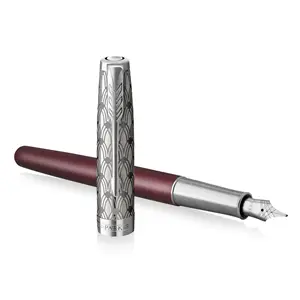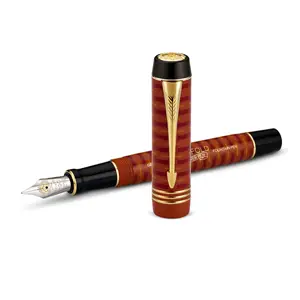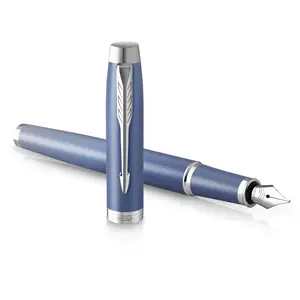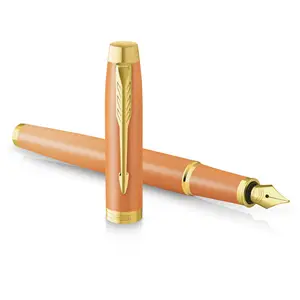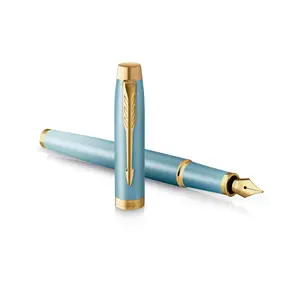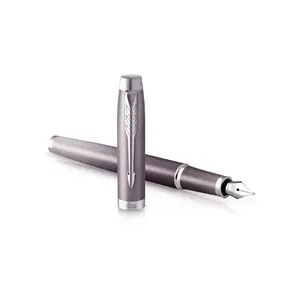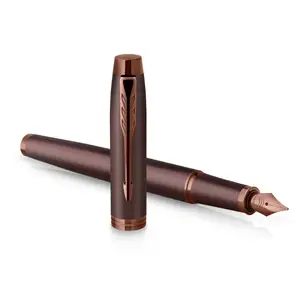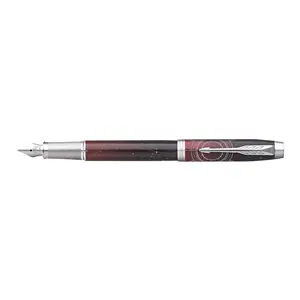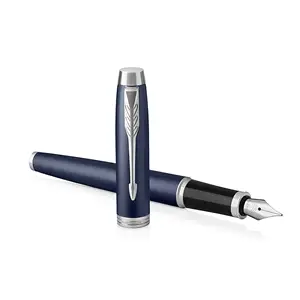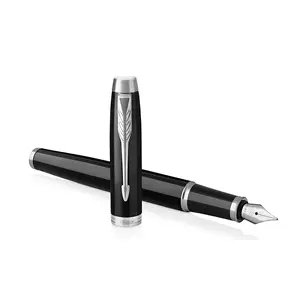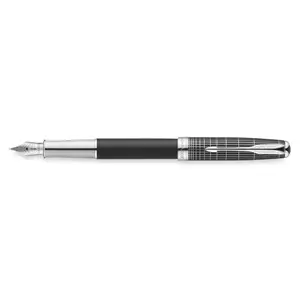Parker Cartridge and Coverter
Parker
4,5 stars, based on
174 reviews
from € 9,00
to € 1580,00
PARKER HISTORY
When he started making pens, George Parker had a simple yet ambitious aim - to make a better pen. And that single, simple vision has powered the Parker Pen Company ever since. In 1888, the Parker Pen Company was founded. In the following year, the first Parker Pen was produced and patented. However, that was only the beginning. Parker's dream of creating better pens led to the major innovation in 1894: the 'Lucky Curve'. This system dramatically reduced the leakage that was a hazard of early fountain pens. 1921 was the year in which Parker's famous icon was born - the Parker Duofold. Although it was considerably larger and more expensive than pens of the time, the Duofold fortunately was an instant success—something to note at a time when America was going through economic depression. In the following year the renowned creator of Sherlock Holmes, Sir Arthur Conan Doyle, began exclusively using a Duofold to pen his stories; quite a testimony in action, by the prolific scrivener, who could compose his magic virtually anywhere, once using the back of a fellow party attendee to bear on, in dashing off a few lines that had come to him on the spot.
During the Great Depression, many smaller pen companies disappeared as others fell into bankruptcy. Many pen companies decided the next best move was to sell their pens at huge discounts, flooding the markets with cheap pens. Parker decided not to compromise and continued to sell their pens at the price they had originally set. Many of their older customers appreciated this move as Parker believed their pens had to hold an image—this image which reflected Parker's vision and dreams.
In 1939, the first Parker 51 was produced and went on to be a global best-seller, topping the other three American pen companies of that time which survived the Great Depression: Sheaffer, Waterman, and Eversharp. The Parker 51 was soon described as "The Most Perfect Pen Ever Produced." In 1954, Parker's first ball pen, The Jotter, was produced. In 1964, the opulent Parker 75 brought a new level of craftsmanship to pens of the era, combining the latest technologies with traditional skills. In celebration of its 100 years of history, 1987 marked the time when Parker returned to its famous icon, the Duofold, by creating the Duofold Centennial Edition. As technology advanced, so did Parker's pens. 1993 saw the introduction of the Sonnet Collection, which has since become as much a signature of Parker as the Duofold before it. In 2002, Parker Special Edition 51 combined the classic futuristic styling of the '51' with the very latest pen technology. In 2004, Parker 100 became the face of Parker for the 21st century, with a combination of avant-garde looks and an affectionate reinterpretation of the unique styling of its illustrious predecessor, the '51.
Also in 2004, Parker experienced a phenomenal blow: the company that had for so long provided the materials for the Duofold Pearl & Black, went out of business. It would be three years before the Pearl & Black made its come-back. It was announced that "by popular demand" the pen that, more than any other, represented the legacy of artistic and cultural refinement, was back; and to celebrate the return of its best, Parker released the fountain pen in Centennial and International sizes. The Art Deco colour and design that recalls the era of classic black and white movies, where Bogie and Bacall, James Cagney, Joan Fontaine, and more, would ever live in romance and intrigue, and pen lovers the world over would once again be able to draw upon that spirit of glamour and adventure, as they took up pen and paper.
In yet another affirmation of its commitment to heritage and technical superiority, Parker reintroduced a 21st century edition of its original ballpoint, the Jotter. Launched in 1954, the best-selling Jotter wasParker's first-ever ballpen. To mark its 50th Anniversary, Parker issued the Jotter Special Edition, a universal, ageless writing instrument that helped to kick off the subsequent 50 years with both prestige and style. The Jotter Jubilee features two types of 50s influenced patterns, elegant matte, and shiny finishes. With its dedicated passion for perfection, and driven by bold innovation, Parker's philosophy to always put customers and craftsmanship first continue to enlighten their goals for future writing instruments. Even today, every Parker pen is carefully checked at every stage of its manufacture—a clear sign of their commitment to quality and their continuing belief in the vision George Parker held all those years ago.
When he started making pens, George Parker had a simple yet ambitious aim - to make a better pen. And that single, simple vision has powered the Parker Pen Company ever since. In 1888, the Parker Pen Company was founded. In the following year, the first Parker Pen was produced and patented. However, that was only the beginning. Parker's dream of creating better pens led to the major innovation in 1894: the 'Lucky Curve'. This system dramatically reduced the leakage that was a hazard of early fountain pens. 1921 was the year in which Parker's famous icon was born - the Parker Duofold. Although it was considerably larger and more expensive than pens of the time, the Duofold fortunately was an instant success—something to note at a time when America was going through economic depression. In the following year the renowned creator of Sherlock Holmes, Sir Arthur Conan Doyle, began exclusively using a Duofold to pen his stories; quite a testimony in action, by the prolific scrivener, who could compose his magic virtually anywhere, once using the back of a fellow party attendee to bear on, in dashing off a few lines that had come to him on the spot.
During the Great Depression, many smaller pen companies disappeared as others fell into bankruptcy. Many pen companies decided the next best move was to sell their pens at huge discounts, flooding the markets with cheap pens. Parker decided not to compromise and continued to sell their pens at the price they had originally set. Many of their older customers appreciated this move as Parker believed their pens had to hold an image—this image which reflected Parker's vision and dreams.
In 1939, the first Parker 51 was produced and went on to be a global best-seller, topping the other three American pen companies of that time which survived the Great Depression: Sheaffer, Waterman, and Eversharp. The Parker 51 was soon described as "The Most Perfect Pen Ever Produced." In 1954, Parker's first ball pen, The Jotter, was produced. In 1964, the opulent Parker 75 brought a new level of craftsmanship to pens of the era, combining the latest technologies with traditional skills. In celebration of its 100 years of history, 1987 marked the time when Parker returned to its famous icon, the Duofold, by creating the Duofold Centennial Edition. As technology advanced, so did Parker's pens. 1993 saw the introduction of the Sonnet Collection, which has since become as much a signature of Parker as the Duofold before it. In 2002, Parker Special Edition 51 combined the classic futuristic styling of the '51' with the very latest pen technology. In 2004, Parker 100 became the face of Parker for the 21st century, with a combination of avant-garde looks and an affectionate reinterpretation of the unique styling of its illustrious predecessor, the '51.
Also in 2004, Parker experienced a phenomenal blow: the company that had for so long provided the materials for the Duofold Pearl & Black, went out of business. It would be three years before the Pearl & Black made its come-back. It was announced that "by popular demand" the pen that, more than any other, represented the legacy of artistic and cultural refinement, was back; and to celebrate the return of its best, Parker released the fountain pen in Centennial and International sizes. The Art Deco colour and design that recalls the era of classic black and white movies, where Bogie and Bacall, James Cagney, Joan Fontaine, and more, would ever live in romance and intrigue, and pen lovers the world over would once again be able to draw upon that spirit of glamour and adventure, as they took up pen and paper.
In yet another affirmation of its commitment to heritage and technical superiority, Parker reintroduced a 21st century edition of its original ballpoint, the Jotter. Launched in 1954, the best-selling Jotter wasParker's first-ever ballpen. To mark its 50th Anniversary, Parker issued the Jotter Special Edition, a universal, ageless writing instrument that helped to kick off the subsequent 50 years with both prestige and style. The Jotter Jubilee features two types of 50s influenced patterns, elegant matte, and shiny finishes. With its dedicated passion for perfection, and driven by bold innovation, Parker's philosophy to always put customers and craftsmanship first continue to enlighten their goals for future writing instruments. Even today, every Parker pen is carefully checked at every stage of its manufacture—a clear sign of their commitment to quality and their continuing belief in the vision George Parker held all those years ago.
Limited edition
- -20%
![Parker Duofold 135th Anniversary Centennial]()
Parker Duofold 135th Anniversary Centennial GT Fountain Pen - Stilografica
€ 1.295,08€ 1.036,07 - -20%
![Parker Sonnet Premium 2021]()
Parker Sonnet 2021 Metal and Red CT Fountain pen - Stilografica
€ 300,82€ 240,66 - -20%
![Parker DUOFOLD 100th Anniversary]()
Parker DUOFOLD 100th Anniversary Big Red Fountain Pen - Stilografica
€ 983,61€ 786,89
Standard edition
![Parker IM RITUALS II]()
Parker IM RITUALS II Blue ST Fountain Pen - Stilografica
€ 63,52![Parker IM RITUALS II]()
Parker IM RITUALS II Orange GT Fountain Pen - Stilografica
€ 63,52![Parker IM Rituals]()
Parker IM Rituals Turquoise Green GT Fountain Pen - Stilografica
€ 63,52![Parker IM Rituals]()
Parker IM Rituals Grey CT Fountain Pen - Stilografica
€ 63,52![Parker IM Monochrome 2023]()
Parker IM Monochrome Burgundy Fountain Pen
€ 59,02- -35%
![Parker IM The Last Frontier]()
Parker IM The Last Frontier Portal Fountain Pen - Stilografica
€ 92,62€ 60,20 ![Parker IM Lacquer]()
PARKER IM Blue CT Fountain Pen - Stilografica
€ 50,82![Parker IM Lacquer]()
PARKER IM Black CT Fountain Pen - Stilografica
€ 50,82![Parker Sonnet 2017]()
Parker Sonnet 2017 BlueCT Fountain Pen - Stilografica
€ 163,11- -20%
![Parker Sonnet 2017]()
Parker Sonnet 2017 Black GT Fountain Pen - Stilografica
€ 192,62€ 154,10 - -30%
![Parker Sonnet Special Edition 2015]()
Parker Sonnet Contort Black Cisele - Fountain Pen - Penna Stilografica
€ 318,03€ 222,62

